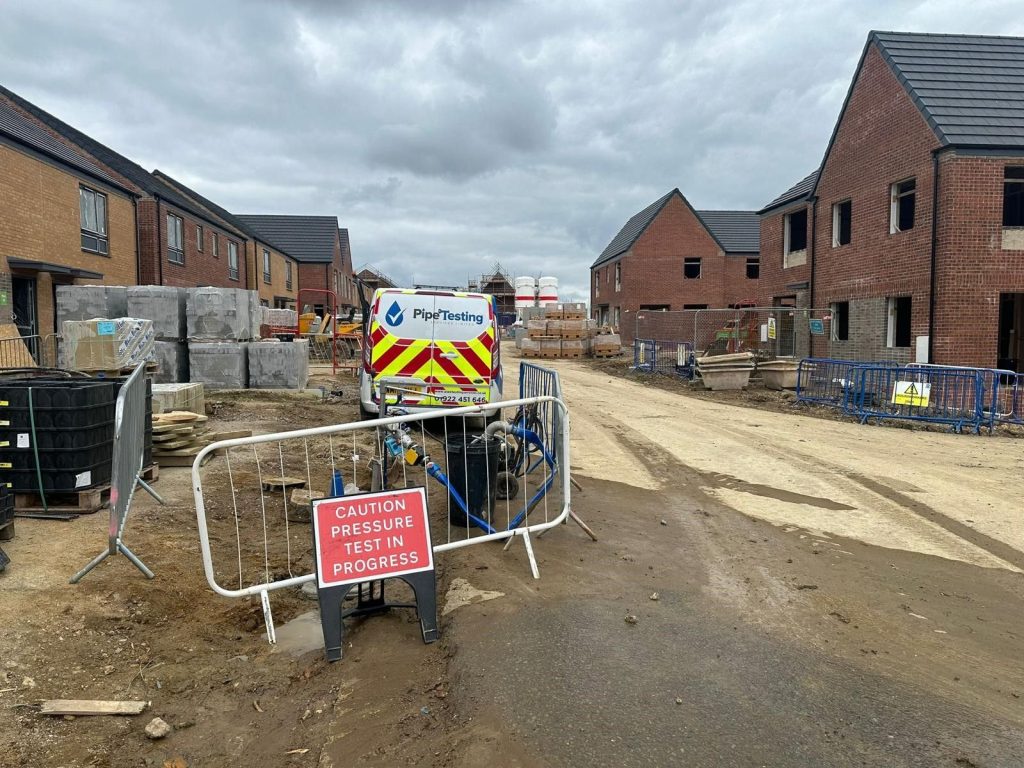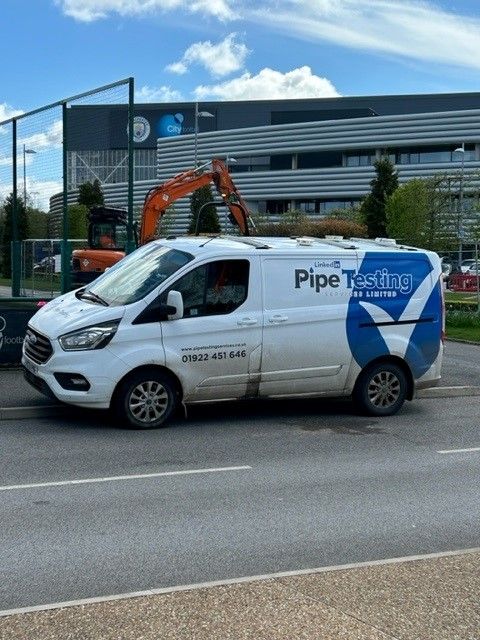Chlorinating Water Lines
Are you confident in the safety of your water supply? Discover why chlorinating water lines is crucial for maintaining clean, healthy water systems across the UK.
From domestic properties to large commercial facilities, proper water treatment is essential for public health and regulatory compliance.
At Pipe Testing Services (PTS), we specialise in water system hygiene, including the essential process of chlorinating water lines. Our nationwide service ensures that your water systems meet the highest standards of safety and compliance, protecting your family, employees, or customers from waterborne health risks.
In need of Chlorination Services? Don’t hesitate to get in touch with our team – we operate nationwide, up and down the country. We’ll present a cost-effective solution. For more information you can take a look at our dedicated site – Pipe Chlorination Services.

Why Chlorinate Water Lines?
Chlorination is a vital step in maintaining water hygiene and preventing waterborne diseases. In the UK, this process is not just recommended—it’s often required by law. Here’s why it matters:
Prevents Contamination
Chlorination effectively eliminates harmful microorganisms like Legionella, Pseudomonas, E. coli, and Cryptosporidium, which can pose serious health risks. These pathogens can cause severe illnesses such as Legionnaires’ disease, gastrointestinal infections, and other waterborne diseases.
Meets Regulatory Standards
UK regulations, including BS EN 806-5:2012 and BS 8558:2011, mandate proper cleaning and disinfection of water systems. The Water Supply (Water Fittings) Regulations 1999 also require new installations to be thoroughly cleaned and disinfected before use. Compliance with these standards is crucial for both legal and safety reasons.
Ensures Water Quality
Regular chlorination maintains the aesthetic, chemical, and microbiological quality of your water supply. This means clearer, better-tasting water that’s safe for all uses, from drinking to bathing.
Protects Public Health
By eliminating harmful bacteria and viruses, chlorination plays a crucial role in protecting public health. This is particularly important in shared water systems, such as those in apartment buildings, hospitals, and schools.
Extends System Lifespan
Regular chlorination can help prevent biofilm formation and reduce corrosion in pipes, potentially extending the lifespan of your water system infrastructure.
When Is Chlorination Necessary?
Several scenarios call for water line chlorination:
- New Installations: Before connecting new pipework to the mains supply, chlorination is essential to eliminate any contaminants introduced during manufacturing or installation
- System Modifications: After substantial changes to existing water systems, such as repairs or extensions, chlorination ensures that no harmful bacteria have been introduced.
- Inactivity: When water has been stagnant for extended periods, such as in seasonal businesses or holiday homes, chlorination helps eliminate any bacteria that may have proliferated during the dormant period.
- Routine Maintenance: Many UK facilities implement regular chlorination as part of their water safety plans, often on an annual basis.
- Contamination Incidents: If testing reveals the presence of harmful bacteria or if there's suspicion of contamination, immediate chlorination is necessary.
These factors combine to make cooling towers a significant source of Legionnaires’ disease outbreaks in the UK. In fact, the Health and Safety Executive (HSE) reports that cooling towers are implicated in up to 30% of all Legionella outbreaks in the country.
What are the Signs that my Water Lines Might Need Chlorination?
Discoloured water, unusual odours, or recent plumbing work are all indicators that chlorination might be necessary. Other signs include:
- Slime or biofilm visible in taps or showerheads
- Unexplained illnesses among building occupants
- Positive tests for Legionella or other waterborne bacteria
- Changes in water pressure or flow rate
The Chlorination Process: A Step-by-Step Guide
Initial Assessment
Our experts conduct a thorough evaluation of your water system, identifying potential risk areas and determining the most effective chlorination approach.
Flushing
We start by flushing the system with clean water to remove any debris, sediment, or loose biofilm. This step ensures that the chlorine solution can effectively reach all parts of the system.
Chlorine Application
A chlorine solution, typically with a concentration of at least 50 mg/l, is introduced into the system. The exact concentration and contact time are determined based on system specifics and UK guidelines. We use state-of-the-art equipment to ensure even distribution throughout the system.
Contact Period
The chlorine solution is left in the system for a specified time, usually several hours, to ensure thorough disinfection. During this period, we may periodically test chlorine levels to ensure effectiveness.
Neutralisation and Disposal
After the contact period, the chlorine is neutralised using sodium thiosulphate or a similar agent. The neutralised solution is then safely disposed of, following strict environmental regulations and local water authority guidelines.
Flushing and Testing
The system is thoroughly flushed with fresh water to remove any residual chlorine. We then conduct comprehensive testing for residual chlorine, microbial contaminants, and other quality parameters.
Certification and Documentation
Upon successful completion, we provide full documentation of the process, including test results certified by UKAS-accredited laboratories, as required by UK standards.
Case Study: Chlorination at Manchester City FC Academy
We recently conducted water pipe chlorination for a new service connection at the Manchester City FC academy’s state-of-the-art facility.
Our challenge for Ensuring proper disinfection and sanitization of the new pipe network for a safe, high-quality water supply to an additional building block.
Our Approach:
- Deployed skilled water treatment specialists
- Prepared and isolated pipework
- Introduced controlled chlorine solution
- Circulated chlorinated water, monitoring residuals
- Flushed system thoroughly
- Conducted comprehensive sampling and testing.
Outcome:
- Fully sanitized piping network for the new building connection
- Met all regulatory standards for water quality
- Client praised our professionalism and timely delivery
Our approach, from initial treatment to final testing, provided the client with a reliable, compliant water system for their prestigious facility. You can read the full case study here.
UK-Specific Considerations
In the UK, chlorination is subject to strict oversight:
- Certification: Results must be certified by UKAS-accredited laboratories to ensure compliance with national standards.
- Local Regulations: Water authorities like Anglian Water, Thames Water, and Scottish Water have specific guidelines for chlorination procedures and acceptable chlorine levels.
- HSE Guidelines: The Health and Safety Executive (HSE) provides guidance on managing Legionella risks, which often involves chlorination as a control measure. You can learn more about Legionella Risks from our recent pages – Understanding Your Legionella Risk Assessment Ratings – UK Property Owners – and; Legionella Risk Assessment – UK Landlords & Businesses.
- Drinking Water Inspectorate (DWI) Standards: The DWI sets and enforces drinking water quality standards in England and Wales, influencing chlorination practices.
Why Choose PTS for Water Line Chlorination?
- Expertise: Our team is highly trained in UK water hygiene standards and stays up-to-date with the latest regulations and best practices.
- Nationwide Service: We operate throughout the UK for both domestic and commercial clients, from small residential properties to large industrial facilities.
- Comprehensive Solutions: From initial assessment to final certification, we handle every step of the chlorination process, ensuring a seamless experience.
- State-of-the-Art Equipment: We use advanced technology for precise chlorine application and testing, ensuring effective and efficient treatment.
- Customised Approaches: We tailor our chlorination methods to suit your specific system requirements and risk profile.
- Emergency Services: We offer rapid response for urgent chlorination needs, such as suspected contamination incidents.
Ready to ensure the safety of your water system? Contact PTS today:
Phone – 01922 451646
Email – enquiries@pipetestingservices.co.uk
Address – Unit 27 Birchbrook Industrial Estate, Shenstone, Lichfield, Staffs, WS14 0DJ
Don’t compromise on water safety. Choose PTS for expert water line chlorination services and enjoy peace of mind. Get in touch now for a consultation!
FAQs – Chlorinating Water Lines
How often should water lines be chlorinated?
The frequency depends on various factors, including system usage, risk assessment results, and local regulations. Generally, it’s recommended annually for most systems. However, high-risk facilities like hospitals may require more frequent treatment. Always consult with a water hygiene specialist to determine the best schedule for your system.
Is chlorination safe for all types of pipework?
While chlorination is safe for most materials, including copper, PVC, and polyethylene, some specialised systems may require alternative disinfection methods. For example, certain rubber compounds or older galvanised pipes might be adversely affected by high chlorine concentrations. Our experts can advise on the best approach for your specific setup, considering factors like pipe material, age, and water chemistry.
How long does the chlorination process take?
The duration varies based on system size and complexity. Typically, it takes between 4-8 hours for a standard residential or small commercial system. However, larger systems, such as those in hospitals or industrial facilities, may require 24 hours or more for complete treatment. We work efficiently to minimise disruption and can often schedule work during off-peak hours.
Can I use my water system during the chlorination process?
No, the system must be isolated during chlorination to ensure safety and effectiveness. Using the water during this time could dilute the chlorine solution and potentially expose users to high chlorine levels. We provide clear guidance on system isolation and when it’s safe to resume normal use.
Are there any environmental concerns with chlorinating water lines?
When performed correctly by professionals, chlorination has minimal environmental impact. We follow strict protocols for neutralisation and disposal of chlorinated water, adhering to guidelines set by the Environment Agency and local water authorities. Our methods ensure that no harmful levels of chlorine are released into the environment.
What regulations govern water line chlorination in the UK?
Several key regulations and standards apply:
- The Water Supply (Water Fittings) Regulations 1999
- BS EN 806-5:2012 (Specifications for installations inside buildings conveying water for human consumption)
- BS 8558:2011 (Guide to the design, installation, testing and maintenance of services supplying water for domestic use within buildings and their curtilages)
- HSE’s Approved Code of Practice L8 (Legionnaires’ disease control) our team stays updated on all relevant regulations to ensure full compliance.

